Burdocks are native, bee-friendly plants that are also edible and may have healing properties.
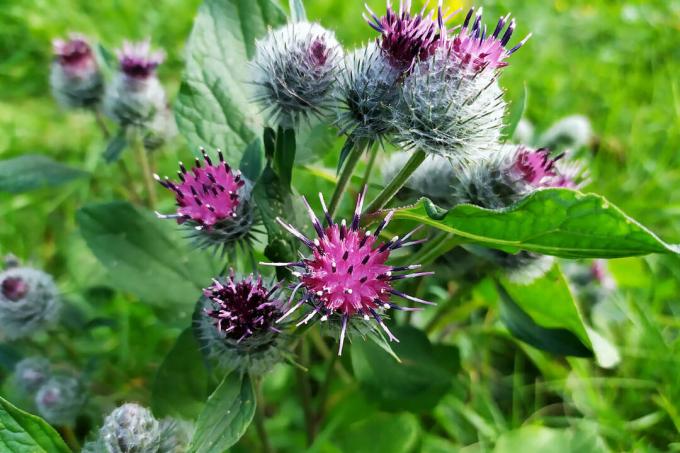
Dog owners can sing a song about the tedious work of collecting the inflorescences and seeds of burdock (atrium) from the fur of the beloved four-legged friend. Incidentally, these adhesive residues served as a model for the Velcro fastener. The rest of the plant also impresses with its properties. In this article you will find a profile on burdock, a guide to planting in your own Garden and some information on the uses and effects of burdock roots and others plant parts.
contents
- Burdock: origin and properties
-
Native burdock species
- Lesser burdock (Arctium minus)
- Greater burdock (Arctium lappa)
- Felt Burdock (Arctium tomentosum)
- Grocery burdock (Arctium nemorosum)
- Planting and caring for burdocks in the garden
-
Use and effect of burdock
- Harvest burdocks
- Great burdock and other burdock use
- Burdock Root Effect
Burdock: origin and properties
To the genus of burdocks (Arctium), which is included in the daisy family (Asteraceae), only include ten to fourteen species. Most of these are native and naturally occurring in Eurasia and North Africa, although burdocks are now widespread around the world. The Latin genus name Arctium is probably derived from the ancient Greek word for bear, since the flowers are said to remind of their felt-like fur.
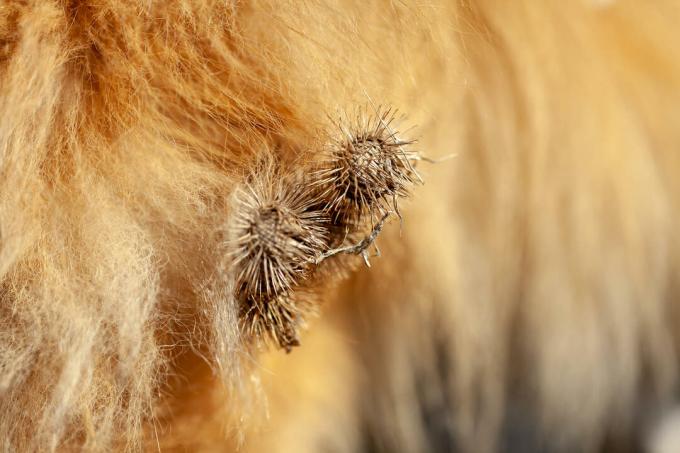
Burdocks are usually biennial. This means they germinate in spring, for example, but only form a rosette of leaves in the first year that survives the winter. The inflorescence with flower heads only develops in the second year. With the seed ripening, the burdock completes its development and the plant dies. However, if the burdock grows in a particularly favorable location or if it is prevented from flowering, a plant can also be more than two years old.
Depending on the species, burdocks can grow to a height of 50 to 300 cm. They are characterized above all by their almost spherical, pink inflorescences, which many individual tubular flowers are composed and you usually from July to September can admire. Also known are their characteristic infructescences, which like to stick to clothing or dog fur. Equally characteristic, if not visible, is the strong taproot of burdock, which reaches up to a meter into the ground. It has long been harvested primarily for its medicinal properties.
Burdocks are among the native bee-friendly plants. Many different insects, such as bumblebees, (wild) bees and butterflies, meet here at pollination time. If you're looking for more bee-friendly plants for your garden, check out our article on them bee-friendly perennials further examples.
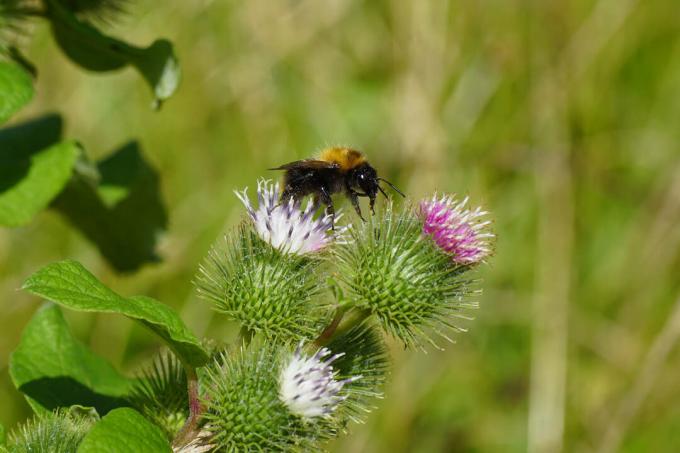
How does burdock spread? Burdocks reproduce by seeds. These can either fall directly to the ground in the fall, where they will germinate the following spring. Alternatively, the infructescence of the burdock, the heads consisting of several seeds, stick with their small hooks in the fur of passing animals. So they are transported to a new location.
Native burdock species
The burdock genus includes a total of between ten and fourteen species. Here we present four types that are among the most common in our country.
Small burdock (Arctium minus)
Contrary to its name, the small burdock can grow to a height of 1.5 to 2 m. The leaves of the lesser burdock are not really small either. For example, the basal leaves of the rosette can grow up to 60 cm long. In contrast to most other types of burdock, the lesser burdock prefers lime-poor to lime-free soil. A distinguishing feature to the greater burdock are the leaf stalks. These are at the Arctium minus hollow, whereas they at Arctium lappa are filled with marrow. The young plant parts of the lesser burdock are edible and are said to taste similar to artichokes when cooked.

Greater burdock (Arctium lappa)
The greater burdock, also known as burdock, is probably one of the best-known species and is relatively high at 80 to 100 cm. The rosette leaves of the greater burdock, which can be up to 50 cm long, provide shady shelter for many beetles and insects other types of insects and also the flowers of the greater burdock are very attractive to bees, bumblebees and the like attractive. The same applies to the other types of burdock presented here. When growing large burdocks, one variety of the subspecies is usually used Arctium lappa var. sativa used to harvest the root. This is characterized by particularly long, unbranched roots.
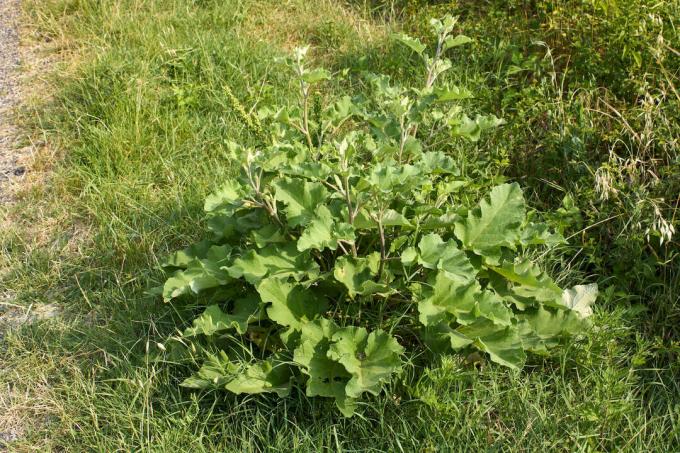
Felt Burdock (Arctium tomentosum)
The felt burdock grows between 60 and 120 cm high and its egg-heart-shaped leaves are usually grey-white hairy on the underside. The plant, also known as felted burdock, can be immediately distinguished from the other species of the genus by the inflorescences. As the name suggests, the felt burrs are covered with a grey-white, woolly felt. Felt burdocks are also edible and can be used in the same way as greater burdocks.
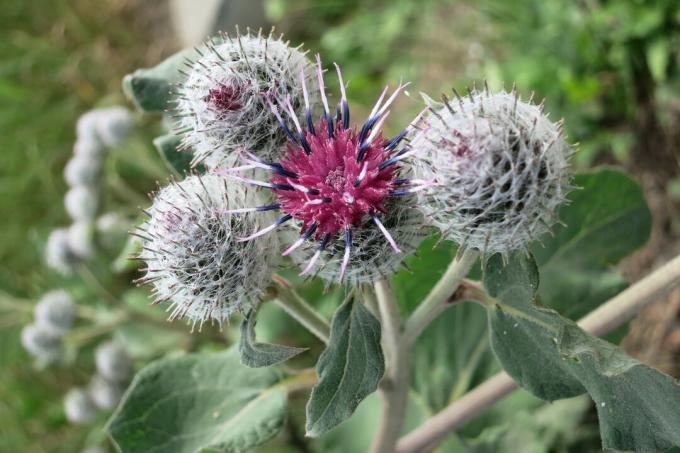
Grocery burdock (Arctium nemorosum)
The grove burdock is very similar to the lesser burdock and it is difficult to distinguish between them. The branches of the inflorescence, which at Arctium nemorosum tend to be bent outwards stand stiffly upright in the lesser burdock, for example. In good locations, the grove burdock can grow up to 250 cm high and thus significantly higher than the small burdock. There are also differences in the location requirements, because grove burdocks tolerate shade better and prefer calcareous soils.

Planting and caring for burdocks in the garden
Growing burdocks in your own garden is not difficult and will help provide food and shelter for insects. Burdocks feel most comfortable in sunny to partially shaded locations with fresh, nutrient-rich soil. Above all, it is important that it is profound, humorous and permeable. Burdocks can be sown directly outdoors. This can be done either in autumn immediately after the seeds have ripened or in spring from April to June. If you sow seeds early in autumn, the burdock may germinate directly and survive the winter as a rosette of leaves. Then it is possible that it will immediately lead to the elongation of the stem and the flower.

Planting burdocks: procedure
- Prepare the soil well by clearing it of weeds and creating a finely crumbly seedbed. Sandy soils, for example, can be treated with our peat-free Plantura organic universal soil or some mature, nutrient-poor compost.
- It is advisable to moisten the substrate well before sowing.
- The burdock seeds are sown about 1 cm deep about 30 cm apart.
- The seed is then covered thinly with soil, pressed a little and watered lightly.
- It takes 3 to 4 weeks to germinate. During this time, the seed should never dry out.
- The germinated plants can be separated in the row at a distance of 20 to 25 cm.
If the location is right, burdock plants hardly need any care. Burdocks should only be watered again and again during long periods of drought. Anyone who grows burdock to harvest the root should ensure a consistently good water supply for higher yields. Fertilization at the start of growth, i.e. around March, and summer fertilization in June are sufficient if a solid fertilizer is used. This can be done, for example, with our Plantura organic universal fertilizer happen with long-term effects. It is completely animal-free and has a high proportion of organic components, which has a positive effect on soil structure and life. Thus, the burdock has the opportunity to develop optimally.
Tip: The hairs on the fruit can cause itching. Therefore, it is advisable to wear gloves when working with mature plants.
Use and effect of burdock
Harvest burdocks
The root of the burdock is mainly harvested. This happens before the burdock flowers, in the fall of the first year of cultivation (around November). Alternatively, it can be harvested in the following spring. Harvesting early also prevents the plant from growing tall and taking up too much space or spreading by itself. At the same time, the advantages of bee-friendliness do not come into play. If you want both, harvest only part of the root by digging it out next to the plant with a spade. Burdock seeds can be harvested in the fall by opening the heads, scooping out the seeds, and freeing them from the hooks.
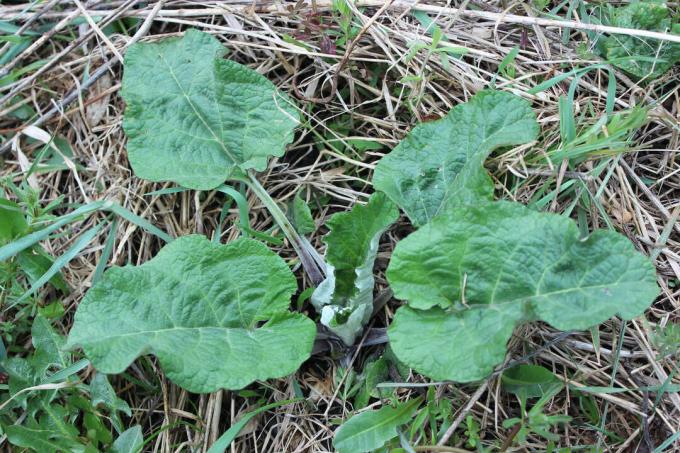
Great burdock and other burdock use
In principle, none of the burdock species mentioned is classified as poisonous. Earlier, burdock roots were eaten as a vegetable, similar to black salsify. Burdock roots are still very common in Japan, making them one of the most popular root vegetables there. The petioles and young leaves of burdock are also edible and used in cooking like spinach. Older leaves taste very bitter, which is why consumption is not recommended. With us, burdocks are less common than vegetables, and if they are, burdocks are cultivated for their medicinal properties. For example, you can prepare a burdock root tea. To do this, pour 250 ml of cold water over a heaped teaspoon of dried burdock root. After five hours of steeping, the tea is boiled for a minute and then strained.
Tip: The seeds of the greater burdock can be cleaned and used in bread, muesli or soups.
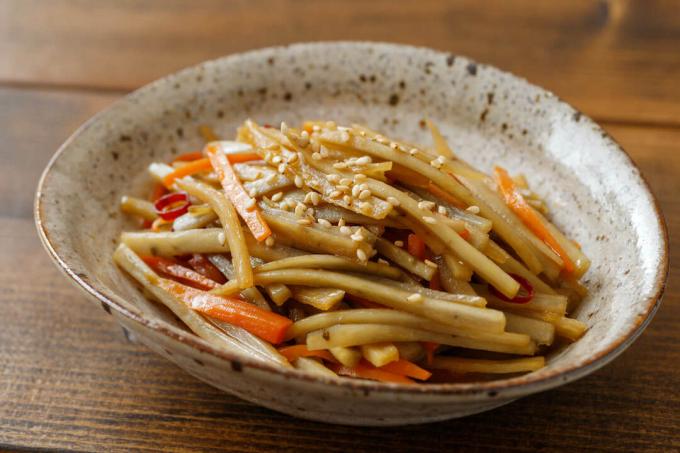
Burdock Root Effect
According to studies, the effects of burdock are anti-inflammatory, anti-carcinogenic, anti-microbial, diuretic and diaphoretic, and regulate hypoglycemic processes. With the latter effect, burdock root tea can be used for diabetes, for example. Nowadays, burdock root is used as a hair oil to prevent hair fall if it is caused by poor blood circulation. In addition to all the positive effects of burdock, one should not ignore potential side effects and risks such as rashes.
Burdock: harvest and uses at a glance
- Harvest time for burdock root: In the autumn of the first year of cultivation or in the following spring.
- Petioles and young leaves: use as a vegetable with a flavor reminiscent of artichokes.
- Burdock Root: Use as a vegetable, base for soups, for burdock root tea or tinctures, oils and ointments.
- Possible effects: Anti-inflammatory, diuretic and diaphoretic, anti-carcinogenic, anti-microbial.
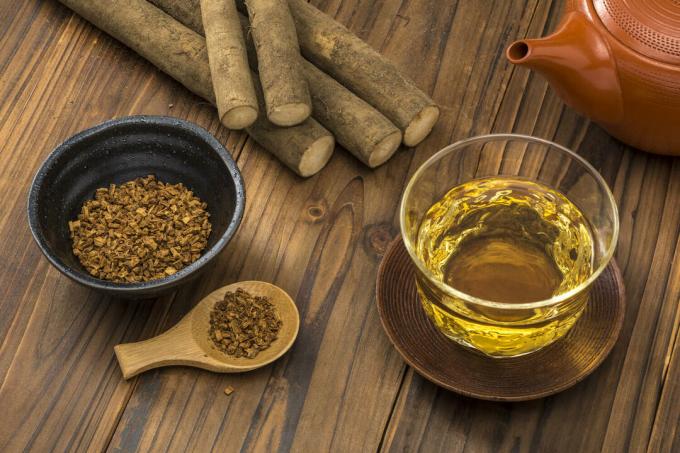
Another herb that is often found naturally in our meadows, but also has its place in the garden, is sorrel. In another article you will therefore find everything you need to know about Planting, care and propagation of sorrel.



